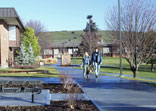BMCC Course Detail
BI 101 General Biology
Offered: Fall
Prerequisites/Co-requisites:
Course Description:
A survey course in biological
science which fulfills the laboratory science requirement for
non-science majors. Topics include biochemistry, cells, genetics,
and evolution .
Text & Reference:
Biology 8 th edition by S.
Mader
Course Goals:
1. categorize organic molecules
(14645)
2. describe atomic/molecular structure (14646)
3.
describe cell organelle functions (14648)
4. compare animal and
plant cells (14648)
5. compare prokaryotic and eukaryotic cell
structure (14648)
6. model eukaryotic meiosis and mitosis
(14650)
7. recognize cell organelles (14648)
8. solve
Mendelian genetics problems (14652)
9. differentiate types of
chemical bonds (14646)
10. connect properties of water with
functions of water in living systems (14646)
11. relate acids and
bases to proper functioning of cells (14646)
12. recognize
importance of carbon as basis of organic molecules (14645)
13.
integrate molecular shape with function (14646)
14. test
properties of biological chemicals (14645)
15. observe cell
structure (14648)
16. apply scientific methodology to lab
experiments (14660)
17. model transport processes across
biological membranes (14648)
18. identify functions of cell
junctions (14648)
19. identify steps of cell division
(14650)
20. explain the function of the cell cycle (14650)
21.
compare mitosis and meiosis (14650)
22. relate meiosis to sexual
reproduction (14650)
23. connect meiosis to genetic recombination
(14650)
24. identify phases of meiosis (14650)
25. predict
outcomes of genetics problems using probability (14652)
26.
interpret Mendelian genetics in modern molecular genetics
(14652)
27. analyze pedigrees to observe inheritance in humans
(14652)
28. apply concepts of modified Mendelian inheritance
(14652)
29. relate gene linkage and chromosome mapping
(14652)
30. explain effects of changes in chromosome number or
structure on phenotype (14652)
31. determine effects of autosomal
and sex linkage on inheritance patterns (14652)
32. model DNA
structure (14679)
33. describe DNA replication (14679)
34.
describe transcription and translation (14679)
35. recognize
connections between protein product and genetic code (14679)
36.
recognize methods of control of gene expression (14679)
37.
describe biotechnology and genetic engineering techniques
(14681)
38. describe evidence for evolution (14683)
39.
discuss evolution as result of natural selection (14683)
40.
describe microevolutionary and macroevolutionary processes
(14683)
41. summarize origins and history of life (14683)
42.
discuss hominid evolution (14683)
43. explore current
issues
44. write lab report
45. understand common genetic
defects
46. relate chemistry to nutrition
Performance Objectives:
14645. The student will not be
allowed references. The student will categorize organic molecules.
Performance will be satisfactory if molecules are categorized and
the categorization is consistent with categorization in the
textbook..
14646. The student will not be allowed references. The
student will describe atomic/molecular structure. Performance will
be satisfactory if structures described are consistent with the
text.
14648. The student will not be allowed references. The
student will compare animal and plant cells. Performance will be
satisfactory if cells are compared and the comparison is consistent
with the textbook.
14650. The student will be a member of BI 101
. The student will model eukaryotic meiosis and mitosis. Performance
will be satisfactory if the models are consistent with the models in
the textbook.
14652. The student will be allowed references. The
student will be provided tools. The student will solve Mendelian
genetics problems. Performance will be satisfactory if problemsare
solved and the solving receives a rating of acceptable from the
instructor.
14660. The student will not be allowed references.
The student will apply scientific methodolo to lab experiments.
Performance will be satisfactory if methods are applied and the
application is consistent with the textbook.
14679. The student
will not be allowed references. The student will recognize
connections between protein product and genetic code. Performance
will be satisfactory if genetic code connectiona are recognized and
the connections are consistent with the textbook.
14681. The
student will not be allowed references. The student will describe
biotechnology and genetic engineering techniques. Performance will
be satisfactory if techniques are described and the description is
consistent with the descritpion in the textbook.
14683. The
student will not be allowed references. The student will discuss
evolution as result of natural selection. Performance will be
satisfactory if natural selection is discussed and the discussion is
consistent with the discussion in the textbook.
Student Contributions:
DISABILITIES STATEMENT - In
order to receive accommodations, qualified students with
disabilities must register every quarter with the Office of Services
for Students with Disabilities (SSWD). Please do so as early in the
quarter as possible. If you believe that you may have a disability
but you do not have documentation please contact the SSWD, which is
found in Morrow Hall, Room M153 or call
278-5807. | 